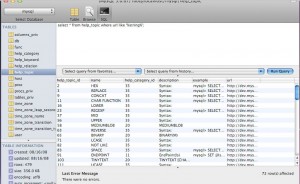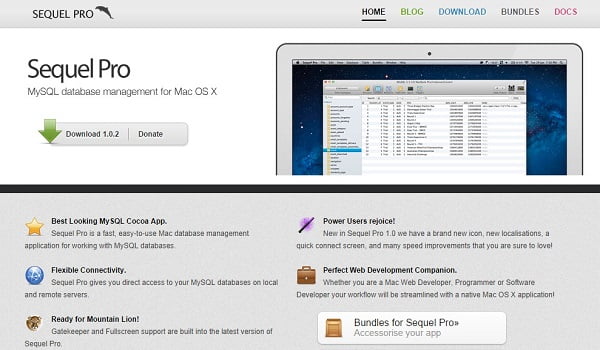

- #Sequel pro search all tables for value how to
- #Sequel pro search all tables for value serial
- #Sequel pro search all tables for value code
You should only do this if your application really does require strict ID ordering. This has a very high performance cost since it makes all INSERT transactions wait for their turn to insert the next ID. Generating monotonically increasing INT IDs by using transactions with roundtrip SELECTs, e.g., INSERT INTO tbl (id, …) VALUES ((SELECT max(id)+1 FROM tbl), …).

This can result in a performance bottleneck because IDs generated temporally near each other have similar values and are located physically near each other in a table's storage.
#Sequel pro search all tables for value serial

The best practices for generating unique IDs in a distributed database like CockroachDB are very different than for a legacy single-node database. Especially when the seldom updated columns are large, it's therefore more performant to assign them to a distinct column family. However, when frequently updated columns are grouped with seldom updated columns, the seldom updated columns are nonetheless rewritten on every update. This default approach ensures efficient key-value storage and performance in most cases. When a table is created, all columns are stored as a single column family. Assign column familiesĪ column family is a group of columns in a table that is stored as a single key-value pair in the underlying key-value store. Row-Level TTL is a mechanism whereby rows from a table are considered "expired" and can be automatically deleted once those rows have been stored longer than a specified expiration time.įor more information, see Batch delete expired data with Row-Level TTL. Batch delete "expired" dataĬockroachDB has support for Time to Live ("TTL") expiration on table rows, also known as Row-Level TTL. To delete a large number of rows, we recommend iteratively deleting batches of rows until all of the unwanted rows are deleted. Use batch deletes to delete a large number of rows This performs better than using DELETE, which performs multiple transactions to delete all rows. The TRUNCATE statement removes all rows from a table by dropping the table and recreating a new table with the same name. Bulk-delete best practices Use TRUNCATE instead of DELETE to delete all rows in a table To bulk-insert data into a brand new table, the IMPORT statement performs better than INSERT. Use IMPORT instead of INSERT for bulk-inserts into new tables
#Sequel pro search all tables for value code
If a multi-row INSERT query results in an error code 40001 with the message "transaction deadline exceeded", we recommend breaking up the query up into smaller batches of rows. Large multi-row INSERT queries can lead to long-running transactions that result in transaction retry errors. Do not include bulk INSERT statements within an explicit transaction. Experimentally determine the optimal batch size for your application by monitoring the performance for different batch sizes (10 rows, 100 rows, 1000 rows). To bulk-insert data into an existing table, batch multiple rows in one multi-row INSERT statement. Bulk-insert best practices Use multi-row INSERT statements for bulk-inserts into existing tables In this case, be sure to use the UPSERT statement. This issue is particularly relevant when using a simple SQL table of two columns Indexes, there is no performance difference between UPSERT and INSERT ON

Statement writes without reading, making it faster. Whereas INSERT ONĬONFLICT always performs a read to determine the necessary writes, the UPSERT Indexes, Cockroach Labs recommends using an UPSERT statement instead of theĮquivalent INSERT ON CONFLICT statement. When inserting/updating all columns of a table, and the table has no secondary Use UPSERT instead of INSERT ON CONFLICT on tables with no secondary indexes
#Sequel pro search all tables for value how to


 0 kommentar(er)
0 kommentar(er)
